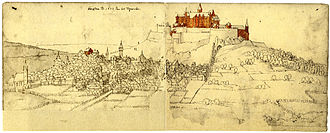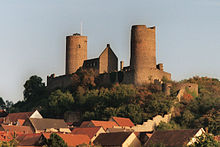Falkensteiner feud
The Falkensteiner Feud (also imperial war against Philipp the Elder von Falkenstein ) was a feud that took place in the Wetterau in the years 1364-1366 . Opponents were Philip VI. from the Licher line of the Lords of Falkenstein on the one hand, the Wetterau bailiff Ulrich III. from Hanau and the imperial cities of Frankfurt , Friedberg , Wetzlar and Gelnhausen on the other side.
Emergence

The origin of the feud lies in the Munzenberg inheritance of the year 1255, in which the rich inheritance of the Munzenbergs in the Wetterau and the Dreieich was initially split into six parts. In the years that followed, the Falkensteiners managed to get five sixths of the inheritance through compensation from co-heirs. The position of the Falkensteiners had become so strong that they now belonged to the leading aristocratic families in the region. For example, Philip I, as the most important partner in the community of heirs, was able to counter the claims of the County of Katzenelnbogen on Dreieich shortly after the inheritance . Only the gentlemen from Hanau held on tenaciously to their sixth. In a series of contracts (1258, 1278, 1288 and 1304 after a shorter feud), the Falkensteiners managed to settle or settle the Hanau residents with the Bachgau , the city of Babenhausen and a sixth of the Münzenberg , Assenheim , Dreieichenhain and other rights in the Dreieich . to limit this to; however, the contrast between Hanau and Falkenstein remained decisive for the history of the region in the 14th century, as Hanau, as Ganerbe, continued to be involved with one sixth in important Munzenberg castles, especially the administrative offices of Munzenberg, Dreieichenhain and Assenheim , which were occupied by castle men . Although the Falkensteiners built a second palas ( Falkensteiner Bau ) in Münzenberg , these castles were not strategically usable in the dispute with Hanau, as the truce had to be observed here.
Through the Falkensteiner inheritance under the sons of Philip I in the lines of Butzbach and Lich , the Hanau position was strengthened in 1271. The important office of the Wetterau governor passed to Ulrich I von Hanau under King Albrecht in 1300 . In Ulrich III. Finally, the Falkensteiners encountered an important personality.
The reason for the feud was the Hanau fortification of Rodheim and the dispute over Falkenstein legal rights in the Hanau district of Bornheimerberg (Falkenstein village rule in the villages of Bischofsheim , Vilbel , Eschersheim , Ginnheim and Nied , which belong to the Hanau district ), and Ulrich also demanded an older debt of Philipp from 4000 fl. Back. In 1363 Ulrich won a lawsuit against Philip VI. von Falkenstein , which was enforceable on his entire property. This particularly threatened the direct joint property in Munzenberg, Assenheim, Dreieichenhain, Lich, Königstein , Hofheim , Rodheim, Hungen and Nieder-Wöllstadt . Since Philip broke the Wetterau imperial land peace in the context of these disputes , the imperial ban was imposed on him in 1365 . Ulrich was therefore able to fight him with the support of the Wetterau imperial cities in his function as provincial bailiff.
Course of the feud

In April 1365 Ulrich, with the help of his allies, succeeded in conquering the city of Lich with the neighboring Warnsberg Castle . The Falkenstein castles and towns of Königstein and Hofheim were also destroyed. The latter was conquered by Kurmainz in 1366 . Finally, the related Butzbach line was drawn into the dispute, but its members fought with the Archbishop of Trier Kuno II von Falkenstein on the side of the Hanau people. Documentary mentioning of the destruction of the towns of Ober- and Nieder-Bessingen , Ettingshausen and Münster , as well as other sloz, stede and burge not mentioned by name, can be proven .
A letter from Trier Archbishop Werner von Falkenstein to the City of Frankfurt from 1414 contains further information about Frankfurt's participation in the feud. After two years of siege, the Frankfurt troops were able to break the Königstein Castle, which suffered great damage from gunfire. The corridor of Lich was also devastated, the castle there destroyed, the new town burned down and plundered. They conquered and occupied Hofheim, besieged and conquered Neufalkenstein Castle and the Ziegenberg Tower . The villages of Schneidhain , Altenhain , Neuenhain , Oberhöchstadt , Schönberg , Nieder-Wöllstadt, Langen , Sprendlingen , Mörfelden and Götzenhain were burned down . In the vicinity of Munzenberg and in the Dreieich forests were cut down and the wood was transported to Frankfurt. On the way from Mainz to Königstein, the Frankfurters took ten carts with wine. It can be seen that the acts of war affected a large part of the eastern Taunus and its foreland, the Wetterau and the Rhine-Main area .
agreement
In the year 1366 Philip was able to use the war weariness of the cities for a favorable peace agreement. The peace between Philipp and Ulrich, brokered after lengthy negotiations on July 11, 1366, left the Falkensteiners Lich, but without Warnsberg Castle. The city of Hofheim was finally lost to Kurmainz. In Rodheim, the fortification of which Ulrich had triggered the feud, in future he was only involved in half.
A few years later, financial difficulties due to outstanding castle loan monies led Philipp to another feud with the Lords of Reifenberg . He died after falling while escaping from the besieged Königstein Castle. In addition, his wife and sons were taken prisoner and had to be raised at a high price by Archbishop Werner von Falkenstein of Trier. Due to the financial difficulties arising from both feuds, his widow Agnes had to transfer Königstein Castle for 7,000 florins to Philip VII von Falkenstein , Ulrich von Hanau and the city of Frankfurt in 1378 . The Falkensteiner territorial policy, which was characterized by castle building, came to an end.
literature
- Klaus-Peter Decker: Gentlemen in the Wetterau. In: Winfried Speitkamp (Ed.): Knights, Counts and Princes - secular dominions in the Hessian area approx. 900–1806. Marburg 2014, ISBN 978-3-942225-17-5 (= Handbook of Hessian History 3 = Publications of the Historical Commission for Hesse 63), pp. 274-325, especially pp. 311f.
- Karl Ernst Demandt : History of the State of Hesse , 2nd edition, Bärenreiter-Verlag , Kassel and Basel 1972, ISBN 3-7618-0404-0 , pp. 446–451, esp. Pp. 449f.
- Karl Ebel: The Imperial War against Philipp the Elder Ä. von Falkenstein 1364-1366. In: Mitteilungen des Oberhessisches Geschichtsverein 23, 1915, pp. 129–142.
- Fred Schwind : The Landvogtei in the Wetterau. Studies on the rule and politics of the Hohenstaufen and late medieval kings. Marburg 1972 (= Writings of the Hessian State Office for Historical Regional Studies 35 ), pp. 139–161 [Ulrich III. von Hanau as governor under Emperor Karl IV] .
- Dieter Wolf : Acts of war in the Reich War against Philipp the Elder Ä. von Falkenstein 1364-1366. In: Wetterauer Geschichtsblätter 23, 1974, pp. 21f.
Individual evidence
- ^ Karl Ernst Demandt: History of the State of Hesse , 2nd edition, Kassel and Basel 1972, p. 446.
- ^ Karl Ernst Demandt: History of the State of Hesse , 2nd edition, Kassel and Basel 1972, p. 447.
- ↑ Klaus-Peter Decker: Lords in the Wetterau. In: Knights, Counts and Princes - secular dominions in the Hessian area approx. 900–1806. Marburg 2014, p. 309.
- ^ Karl Ernst Demandt: History of the State of Hesse , 2nd edition, Kassel and Basel 1972, pp. 447–449.
- ↑ Fred Schwind: The Landvogtei in the Wetterau. Studies on the rule and politics of the Hohenstaufen and late medieval kings. Marburg 1972, p. 148.
- ^ Karl Ernst Demandt: History of the State of Hesse , 2nd edition, Kassel and Basel 1972, p. 449.
- ↑ Klaus-Peter Decker: Lords in the Wetterau. In: Knights, Counts and Princes - secular dominions in the Hessian area approx. 9001806. Marburg 2014, p. 311.
- ^ Heinrich Reimer : Hessisches Urkundenbuch. Section 2, document book on the history of the Lords of Hanau and the former province of Hanau. Vol. 3, 1350-1375. Hirzel, Leipzig 1894, no.498.
- ↑ City Archives Frankfurt, Reich things I, 1453/2 §§ 1-18; 1453/3 = Answer of the City Council of Frankfurt from January 1st, 1415.
- ↑ Dieter Wolf: Acts of War in the Reich War against Philipp the Elder. Ä. von Falkenstein 1364-1366. In: Wetterauer Geschichtsblätter 23, 1974, pp. 21f.
- ↑ Klaus-Peter Decker: Lords in the Wetterau. In: Knights, Counts and Princes - secular dominions in the Hessian area approx. 900–1806. Marburg 2014, p. 311f.
- ^ Horst Wolfgang Böhme : Castle building art and striving for power on the Middle Rhine and Taunus during the late Middle Ages. In: Franz J. Felten (Ed.): Fortifications and castles on the Rhine. Steiner, Stuttgart 2011 (= Mainzer Lectures 15), ISBN 978-3-515-10072-4 , pp. 47–73, here pp. 54f.
